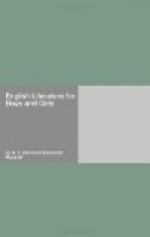Chapter XLIX JONSON—“THE SAD SHEPHERD”
ALTHOUGH Ben Jonson’s days ended sadly, although his later plays showed failing powers, he left behind him unfinished a Masque called The Sad Shepherd which is perhaps more beautiful and more full of music than anything he ever wrote. For Ben’s charm did not lie in the music of his words but in the strength of his drawing of character. As another poet has said of him, “Ben as a rule—a rule which is proved by the exception—was one of the singers who could not sing; though, like Dryden, he could intone most admirably."*
Swinburne.
The Sad Shepherd is a tale of Robin Hood. Here once more we find an old story being used again, for we have already heard of Robin Hood in the ballads. Robin Hood makes a great fest to all the shepherds and shepherdesses round about. All are glad to come, save one Aeglamon, the Sad Shepherd, whose love, Earine, has, he believes, been drowned. But later in the play we learn that Earine is not dead, but that a wicked witch, Mother Maudlin, has enchanted her, and shut her up in a tree. She had done this in order to force Earine to give up Aeglamon, her true lover, and marry her own wretched son Lorel.
When the play begins, Aeglamon passes over the stage mourning for his lost love.
“Here she was wont to
go! and here! and here!
Just where those daisies,
pinks, and violets grow,
The world may find the spring
by following her,
For other print her airy steps
ne’er left.
Her treading would not bend
a blade of grass,
Or shake the downy blow-ball
from his stalk!
But like the soft west wind
she shot along,
And where she went the flowers
took thickest root—
As she had sowed them with
her odorous foot.”
Robin Hood has left Maid Marian, Friar Tuck, Little John, and all his merry men to hunt the deer and make ready the feast. And Tuck says:
“And I, the chaplain,
here am left to be
Steward to-day, and charge
you all in fee,
To don your liveries, see
the bower dressed,
And fit the fine devices for
the feast.”
So some make ready the bower, the tables and the seats, while Maid Marian, Little John and others set out to hunt. Presently they return successful, having killed a fine stag. Robin, too, comes home, and after loving greetings, listens to the tale of the hunt. Then Marian tells how, when the huntsmen cut up the stag, they threw the bone called the raven’s bone to one that sat and croaked for it.
“Now
o’er head sat a raven,
On a sere bough, a grown great
bird, and hoarse!
Who, all the while the deer
was breaking up
So croaked and cried for it,
as all the huntsmen,
Especially old Scathlock,
thought it ominous;
Swore it was Mother Maudlin,
whom he met
At the day-dawn, just as he
roused the deer
Out of his lair.”




